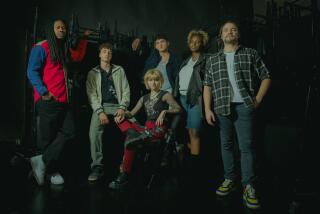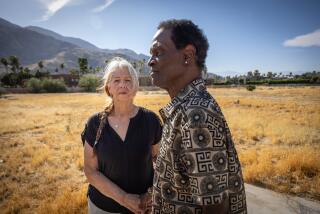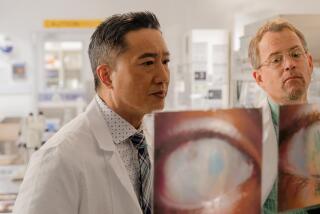Putting an end to 65 years of silence
IN fall 2004, documentary filmmaker Irene Taylor Brodsky was caught off guard when her 65-year-old parents, both profoundly deaf since birth, announced that they had made a life-altering decision: They would both undergo cochlear implants. In three weeks.
“I was like, ‘Whoa, what are you talking about? I didn’t even know you were thinking about it!’ ” said Brodsky, who lives in Portland, Ore.
But the former producer for CBS News’ “Sunday Morning” soon got over her shock and realized that a terrific opportunity had landed in her lap. She gathered a crew and made the cross-country trek to her parents’ home in Rochester, N.Y., where she would film the surgeries, then follow Paul and Sally for a year as their silent world became a sometimes frustrating cacophony.
“They’ve been daydreaming about sound their whole lives,” says Brodsky, who narrates the film. “But what if hearing disappoints us all?”
That is the crux of this exhilarating and often heart-wrenching film, which will be at the ArcLight today through Thursday as part of the International Documentary Assn.’s DocuWeek. It will be shown on HBO, which funded the production, early next year.
“Hear and Now” is both a family love story and a suspenseful tale about the perils of trying to fulfill what may be an impossible dream. Thanks in part to her father’s quiet dignity and her mother’s tendency to wear her heart on her sleeve, Brodsky manages to create an endearing portrait of two people for whom you can’t help but root. At this year’s Sundance Film Festival, where the film received an audience award for favorite documentary, the hankies were out at every screening.
“I kept hearing people blowing their nose,” said Brodsky, “and I kid you not, I was like, ‘Man! Are people getting sick already?’ And then I really realized they were crying. I could see people wiping their eyes. And they’d come up afterwards to talk and their voices would be cracking. I wasn’t quite prepared for that.”
In an interview over cups of hot tea at a big Deer Valley, Utah, house that Brodsky had rented for her parents, extended family and a slew of friends during the festival, Brodsky was able to translate her parents’ speech, which can be difficult to understand. (The film has subtitles.)
The Taylors seemed faintly amused by the tremendous emotions inspired by the film. It’s just their life, after all, and one they have lived nearly oblivious to the limitations imposed by deafness. In the film, Paul remembers his mother pushing him in his stroller weeping, because, as he puts it, “I would never speak. . . . I would never have a life.”
She needn’t have worried; he became a college professor and engineer who helped invent a technology that would help deaf people communicate by phone.
Sally was the gossip editor of her high school newspaper and became an expert lip reader.
Together, the Taylors raised three hearing children for whom parental deafness was a simple fact of life.
A new world
There are many charming, poetic moments in the film. Sally walks a country road before her surgery, saying, “I don’t see anything to hear. Will I hear the birds flying?” Paul muses that the surgery might change him in a profound way: “I could maybe become a more bold person and do stuff I could never dream of.”
“That,” said Brodsky during the interview, “is the one quote in the film that breaks my heart. I felt so sad, because I think the world of him and how can he say that about himself?”
The Taylors met as children at the Central Institute for the Deaf, a residential school in St. Louis that taught the then-groundbreaking “oral method,” a combination of lip reading and speech. The Taylors seem to have been model students -- learning to speak, to “hear” music by feeling the vibrations of a speaker and to lip read efficiently -- so much so that in Sally’s case, she was sometimes hired by police investigators and journalists to figure out what people were saying from as far away as 100 yards.
Brodsky unearthed lots of footage from her parents’ childhoods as well as her own. “In a lot of ways, it’s a family album, especially those films which came in these old tin reels in a steel box that my father gave me,” she said. “He’d forgotten about them. We had them professionally transferred to digital video. . . . There are definitely some beneficial byproducts of making a film about your family.”
There are images of Paul’s return from boarding school for his first vacation, at what appears to be age 5 or 6. He recounts his parents’ thrill when he spoke his first word -- not “Mommy” or “Daddy,” he said, but “thumb.” “They were over the moon,” he says.
During the Taylors’ 1964 trip to the New York World’s Fair to celebrate their first anniversary, also captured on film, the pair is thunderstruck by Bell Lab’s futuristic Picture Phone. “Why can’t we have a picture phone?” Paul mouths to the camera. “Why don’t deaf people have the right to communicate over the miles the way hearing people do?” Later, he would contribute to the invention of the TTY device that connects the deaf and hearing through Teletypes and telephones. At one point, he worked for the FCC in Washington, helping implement the law that requires relay operators to be available to the deaf and hard of hearing at all times.
While much of the family footage is evocative of just about any middle-class household of its era, some underscores the challenges of deaf parents raising a hearing brood. Paul Taylor got around some of the problems by rigging lights to blink when the babies cried or people rang the doorbell. “Our house was always lighting up like a Christmas tree,” says Brodsky in the film.
Her brother, David, reveals a poignant memory about his feeling of powerlessness when the neighborhood bully ran up behind his father and, telling his friends to “watch this,” yelled an obscenity that only the little boy could hear.
“Hear and Now” steers clear of deaf-community controversies such as the debate over signing versus lip reading, nor does it even explore in much depth what cochlear implants -- electronic devices that stimulate auditory nerves rather than amplify sound like traditional hearing aids -- are capable of doing for the profoundly deaf (and there is controversy about this, as well). The Taylors’ surgeon, who doesn’t think any kind of psychological evaluation is necessary, believes that cochlear implants represent “the No. 1 medical advance of the 20th century,” even more important than organ transplants, he says, because hearing is “the only sense that can be restored.”
In a classic doctor/patient disconnect, Sally’s tumultuous recovery finds her falling apart in his office, telling him that “emotions play a big part in the process.” His response as his patient, who is too dizzy to walk, sits weeping: “A little.”
But all that is really beside the point as the tension builds over whether the Taylors’ lives will dramatically change for the better with the implants.
In another post-op appointment, the Taylors’ audiologist turns on a noise-emitting machine to test their ability to hear.
“What does it sound like?” he asks.
“That’s tough,” Paul replies. “How do you describe what green looks like?”
--
More to Read
The biggest entertainment stories
Get our big stories about Hollywood, film, television, music, arts, culture and more right in your inbox as soon as they publish.
You may occasionally receive promotional content from the Los Angeles Times.











